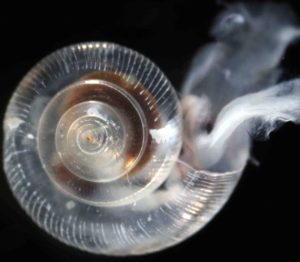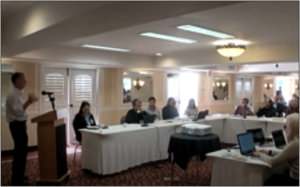Expert panel completes review of coastal OAH modeling tools

An international panel of scientific experts has completed an independent review of a set of computer modeling tools designed to predict how land-based coastal discharges are influencing ocean water quality, including the trajectory of ocean acidification and hypoxia (OAH) in California coastal waters.
The independent review panel found that the tools are built on fundamentally sound science and are ready to be used to study the influence of treated wastewater discharges on coastal ecological health. Panelists recommended specific actions to increase community confidence and acceptance of the tools’ predictive capabilities, including quantifying model uncertainty and making the modeling outputs and other work more accessible to a broad community of end users.
The six-member panel, which published its findings in a 44-page report released in October, offered a detailed roadmap for recommended next steps the modeling science team could take, even as the team uses the model to answer key questions that managers will need as they consider taking action to mitigate the ecological effects of OAH.
Facilitated by the National Water Research Institute, the independent review involved establishing a steering committee – comprised of water-quality regulatory agencies, the regulated community and environmental advocacy groups – that governed the process of selecting panelists and established panel charge questions. The six selected panelists are internationally renowned for their expertise in areas including physical and biogeochemical oceanography, ocean numerical modeling, the biological effects of low oxygen and pH levels, and the application of models to support management decisions.
With the release of the panel’s findings and recommendations, SCCWRP member agencies have agreed the steering committee is the appropriate body to continue guiding the modeling science team’s next steps.
The steering committee will be tasked with addressing two main issues going forward:
- The committee needs to prioritize among the panel’s 40 individual recommendations, which represent millions of dollars in investments in modeling science. The committee must decide which recommendations to fund and when, and how implementation costs should be shared among stakeholders.
- The committee needs to provide guidance about which specific nutrient-reduction modeling scenarios the science team should use as the basis for future modeling runs, given that the scenarios need to be aligned with management decision-making processes.
The coastal ocean water-quality model that was reviewed by the expert panel is made up of two component models – collectively known as ROMS-BEC (Regional Ocean Modeling System-Biogeochemical Elemental Cycling) – that work in tandem to predict the relative influence of natural oceanic sources of nutrients vs. local nutrient discharges on seawater chemistry and low trophic ecosystems. Local nutrient discharges are introduced to the coastal ocean via wastewater effluent discharges, stormwater runoff, and atmospheric deposition.

An associated set of biological modeling tools translates how ROMS-BEC’s predictions about changing ocean chemistry will adversely affect the health of vulnerable marine life.
The modeling tools were developed in response to a 2016 report from the West Coast OAH Science Panel, which recommended developing and applying ocean numerical modeling tools to investigate if managing local, land-based nutrient discharges could be a viable strategy for mitigating OAH conditions.
OAH is a global phenomenon in which seawater is moving to an incrementally more acidic state, and dissolved oxygen levels are falling to create hypoxic conditions for marine life. Given that the West Coast is uniquely vulnerable to OAH due to ocean circulation patterns, the modeling tools are designed to predict whether elevated levels of local, land-based nutrient discharges from dense population centers along the coastline are exacerbating local OAH conditions.
For more information, contact Dr. Martha Sutula and Dr. Faycal Kessouri.
More news related to: Climate Change, Ocean Acidification and Hypoxia, Top News